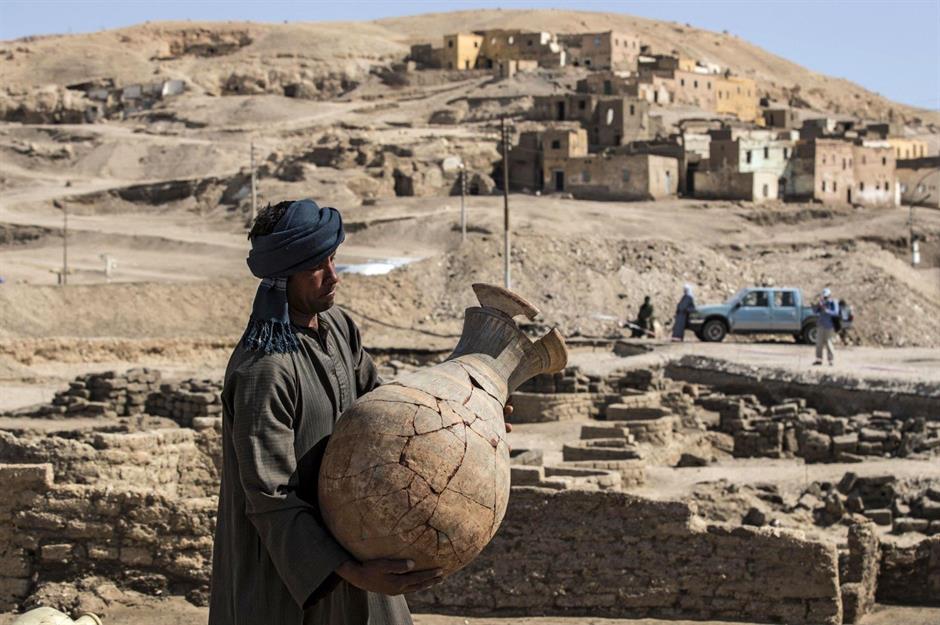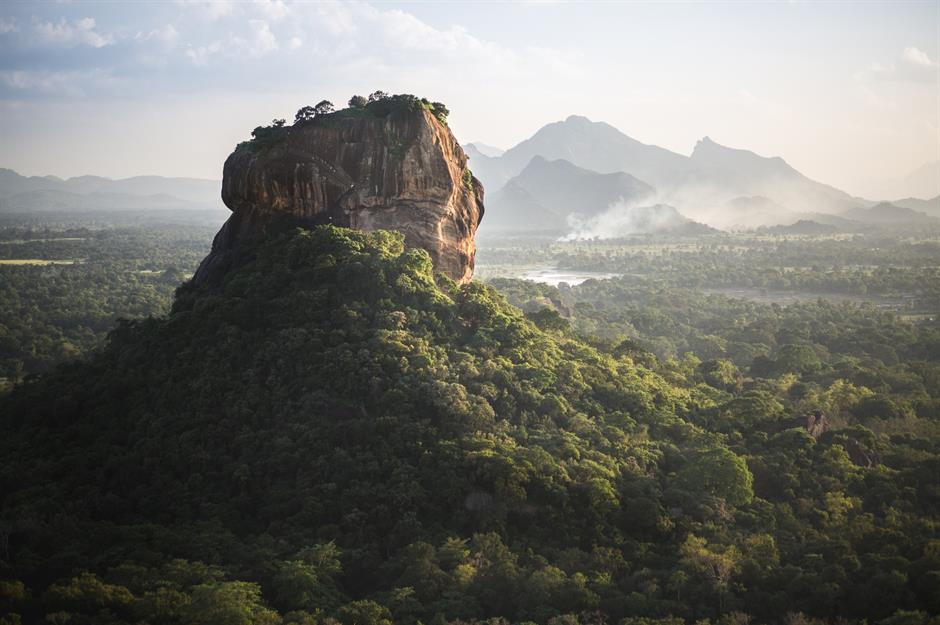The world’s amazing lost cities recently rediscovered
Lost cities found
Founded, flourished and eventually forgotten – this has been the fate of many cities since ancient times. A few names have stayed alive in legend and literature while others disappeared completely – until a chance discovery brought these mysterious metropolises back from the dead. From Sigiriya, the amazing hilltop site in Sri Lanka, to the astonishing Pompeii in Italy, we look at some of the most fabulous cities lost and reborn.
Click through the gallery to unearth the world's rediscovered ancient cities...
Sigiriya, Sri Lanka
Sigiriya, Sri Lanka
Sigiriya means lion and the city is fronted by a huge lion entrance – sadly missing its head. Sigiriya was constructed on a rocky outcrop 650 feet (200m) above the jungle, initially as a 3rd century BC Buddhist monastery. Then 800 years later, King Kasyapa built an opulent palace there and covered it in frescoes. The palace was surrounded by gardens, pools and a mirrored wall that was polished so brightly the king could see his face in it.
Sigiriya, Sri Lanka
It takes around an hour to climb the 1,200 steps to the top of the rock, but the trek rewards with the sight of the Sky Palace surrounded by amazing gardens, pools and moats plus colourful frescoes. Called by some the Eighth Wonder of the World, UNESCO recognised Sigiriya as a World Heritage Site in 1982.
Sanchi, India
Sanchi, India
Taylor had discovered a 3rd century BC Buddhist complex built by the emperor Ashoka. At the time, Buddhism was relatively unknown, but Ashoka was drawn to its message of peace. He built a Great Stupa or domed temple guarded by four gateways carved with scenes from Buddhism. However, by the 13th century AD, the centre was abandoned.
Sanchi, India
Sanchi can be reached by bus or car from Bhopal airport. The preservation of the site is astonishing and visitors can take in the Great Stupa, one of three such structures, plus 50 other monuments and a monastery. In 1989, Sanchi was named a UNESCO World Heritage Site.
Love this? Follow our Facebook page for more travel inspiration
Pompeii, Italy
In 1748, The Duke of Naples was having a summer palace built 14 miles (24km) south of Naples on Italy’s west coast. As workmen dug foundations, they came across the buildings and streets of a lost city and treasure hunters and art collectors descended on the scene. It dawned on people that this was the lost and largely forgotten Roman city of Pompeii – destroyed by the eruption of Mount Vesuvius one day in the summer of AD 79.
Pompeii, Italy
Pompeii, Italy
Today Pompeii is one of the most popular tourist attractions in the world, with over two million annual visitors. It’s astonishing to see this world trapped in time with the colours of the wall paintings as fresh as if they had just been done. And the excavations still continue with much of the city yet to be uncovered and surprising secrets still being unravelled. This city became a UNESCO World Heritage Site in 1997.
Caral, Peru
Caral, Peru
Tanis, Egypt
If you've ever seen the Indiana Jones movie Raiders of the Lost Ark you'll be familiar with the fictional version of Tanis. But the real-life story behind the city is just as amazing as the one from the film. In 1939, Pierre Montet's team was excavating around 100 miles (160km) northeast of Cairo, looking for the city called Zoan which in the Bible was where baby Moses was found. Montet uncovered burial chambers, huge temples and an urban complex.
Tanis, Egypt
Qalatga Darband, Iraqi Kurdistan
Qalatga Darband, Iraqi Kurdistan
Mohenjo-daro, Pakistan
In 1922, R. D. Banerji, an official with the Archaeological Survey of India, was investigating what he thought was a Buddhist monument in the Sindh province of what's now Pakistan. He guessed the site dated to around 500 BC, but when he made some trial trenches, he realised it was far older. His boss, John Marshall, made further excavations in the 1920s and 1930s and deduced the city actually dated from around 2500 BC.
Mohenjo-daro, Pakistan
Mohenjo-daro was one of the largest settlements of the ancient Indus Valley and home to 50,000 people. Buildings uncovered include a Great Bath, an elaborate sewage system with 700 freshwater wells and a grid system of housing. Its residents were a prosperous community, as artefacts made of ivory and gold have been found. They are believed to have been traders with standardised seals and weights.
Mohenjo-daro, Pakistan
The city went into decline around 1900 BC and was abandoned. Although it became a UNESCO World Heritage Site in 1980, sadly the mud-brick buildings remain at risk of damage from the salty waters of the nearby Indus River.
Xanadu, China
When British diplomat Stephen Bushell trekked into the prairie land of inner Mongolia in 1872 in search of Xanadu, he wasn’t the only one whose imagination had been captured by the lost 13th-century city. Seventy-five years earlier the English writer Coleridge had penned a poem based on a historical description of the fabled metropolis. But it was Bushell who, about 220 miles (350km) north of Beijing, made the rediscovery. Its walls featured ruined palaces strewn with blocks of marble and stone lions and dragons. The city gate was intact under a 20-foot (6m) arch.
Xanadu, China
Xanadu, China
Troy, Turkey
When German businessman and adventurer Heinrich Schliemann started an archaeological dig on Turkey’s Aegean coast in 1868, he was convinced he’d found Troy – the city made famous by Homer’s epic poem The Iliad. While Schliemann certainly had found a magnificent ancient city, in truth there’s no ironclad proof the ruins really are the Troy featured in the ancient story, or indeed that a Trojan war ever took place. Nowadays the city is known as Hisarlik.
Troy, Turkey
Legend says that Troy, also known as Ilium, was placed under a 10-year siege by the Greeks after Paris of Troy abducted Helen Queen of Sparta. This is thought to have taken place around 1200 BC. But the site Schliemann discovered had been occupied from around 4000 BC for about 3000 years, with the buildings and walls of seven settlements discovered. Troy was made a UNESCO World Heritage Site in 1998.
Machu Picchu, Peru
Machu Picchu, Peru
Machu Picchu, Peru
Today, you can reach Machu Picchu by train from Cusco then take a bus to the entrance. It can also be accessed on foot from the town of Aguas Calientes, but it’s a strenuous 90-minute climb. Note that there's a cap on daily visitor numbers (around 4,500, though sometimes more) so it's best to book online in advance for a timed slot. Excavations continue and as pathways run off into the jungle, there may yet be more discoveries. The city became a UNESCO World Heritage Site in 1983.
Skara Brae, Orkney, Scotland, UK
Skara Brae, Orkney, Scotland, UK
Skara Brae, Orkney, Scotland, UK
The Lost City, Colombia
The Lost City, Colombia
The Lost City, Colombia
Today, nearly an acre of the Lost City is open to tourists, although a far bigger area remains hidden by thick foliage. The only way to get there is via a strenuous, five-day hike, culminating in a thigh-burning climb up some 1,200 steps. But the effort is rewarded, as this sacred jungle spot features magnificent tiered terraces, ancient stone paths and incredible views.
Vijayanagara, India
Vijayanagara, India
Vijayanagara, India
In 1565, a war ruined the city and it was abandoned. Nowadays, the wonderfully restored monuments are part of the UNESCO World Heritage Site of Hampi, which lies in Vijayanagara in central Karnataka state. Highlights include the huge steps to the audience hall and the underground green soapstone passages to the elephant stables.
Aten, Egypt
In September 2020, archaeologist Dr Zahi Hawass and his team began searching for a temple near the city of Luxor, on the west bank of the Nile. They got a little more than they bargained for. On 8 April 2021, they announced the discovery of an entire 3,000-year old city which had been buried under sand for thousands of years. Aten, also known as the 'Lost Golden City', is thought to be the largest ancient city ever uncovered in Egypt. The significance of the find was compared to the discovery of Tutankhamen’s tomb.
Aten, Egypt
Aten, Egypt
There’s also evidence of working life here, from a bakery (complete with ovens) to a workshop, containing mud bricks for building temples and tombs, as well as casting moulds used to create amulets. But one of the most mysterious discoveries at Aten was a human skeleton, found “with arms outstretched to his side, and remains of a rope wrapped around his knees”, according to the team’s statement.
Now check out 66 of the world's unmissable cultural and natural wonders

